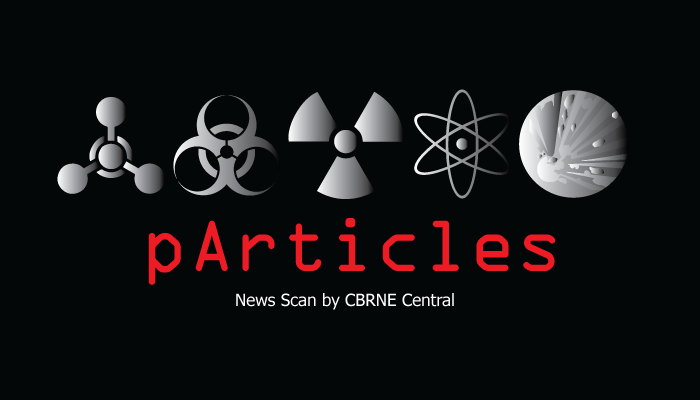Topics in this issue include microbial forensics, disaster response video games, the Chernobyl Exclusion Zone, and CBRNE training exercises at DRDC Suffield.
In This Article
They’re Super Healthy, But Dying of Heart Disease. What’s Happening to Astronauts?
They were among the healthiest people in the country, but several Apollo astronauts succumbed early in life to heart disease — and deep space radiation may be to blame, according to a study published Thursday in Nature’s Scientific Reports. STAT News >>
Every Baby Born in 2016 Contains Atom Bomb Radiation — Here’s Why
Hundreds of bombs detonated in the open air (and several more in the ocean) during the heyday of atmospheric nuclear testing — with thousands more tests conducted underground. The 1963 Partial Test Ban Treaty put a stop to exposed American and Soviet explosions, though France and China continued atmospheric tests until 1974 and 1980, respectively. Many countries pursued underground testing through the early 1990s. Only North Korea has detonated a weapon in the 21st Century. Tech Insider >>
Army Releases Disaster Response Video Game
A new Army video game is taking soldiers into the heart of foreign disaster zones and delivering real-world training from their laptop or tablet. A joint task force — including U.S. Army South, the Army Research Laboratory, the office of foreign disaster assistance and the Army games for training program — has put Disaster Sim into the hands of soldiers after two years of research and development. Armed with Science >>
UN Meeting Says: Time to Negotiate a Nuclear Ban Treaty
For decades, countries without nuclear weapons have called on countries with nuclear weapons to do things — from reducing numbers to sharing information. These nuclear free countries have done things themselves — to verify that they are not trying to build nuclear weapons. There are only a very few exceptions — Iran, Syria, North Korea — but otherwise this non-proliferation regime has held up. HuffPost >>
Chernobyl Has Turned Into an Unlikely Poster Child for Environmentalism
a new legacy has begun to blossom from the ashes of the Chernobyl Exclusion Zone (CEZ), the 1,000-square-mile territory surrounding the remains of the ill-fated Ukrainian power plant and its neighboring city of Pripyat. Once the site of the worst nuclear disaster in history, Chernobyl is becoming an unlikely poster child for sustainable energy and environmental renewal. War Is Boring >>
Why We Might Only Be a Hack Away from Nuclear Disaster
How close are we nuclear disaster? Experts say it could only be a hack away. Eric Schlosser, the author behind Fast Food Nation, has tackled our risk for nuclear disaster in his 2013 book, Command and Control. Schlosser says that nuclear weapons are one of the greatest advancements yet also the greatest threats to U.S. civilization and our well-being. Fortune >>
Car Bombing in Benghazi Kills 23 People
A Libyan hospital official says 23 people have been killed and dozens wounded in a suicide car bombing in the eastern city of Benghazi. The official says that bodies are still arriving at the hospital in the aftermath of the bombing Tuesday evening in the al-Qawarsha district on the outskirts of the city. For the past two years, fighting has been raging in Benghazi between forces under the command of Brig. Gen. Khalifa Hifter and Islamic militias. Time >>
Rescuers Say Toxic Gas Dropped On Syrian Town Where Russian Helicopter Shot Down
A Syrian rescue service operating in rebel-held territory said on Tuesday a helicopter dropped containers of toxic gas overnight on a town close to where a Russian military helicopter had been shot down hours earlier. Reuters Canada >>
More Than 400 Government Files Missing from National Archives
More than 400 government documents have gone missing from the National Archives in the last four years. They include Foreign Office files from the 1970s on “military and nuclear collaboration with Israel” and a 1947 letter from Winston Churchill. BBC News >>
Expansion of Microbial Forensics
Microbial forensics has been defined as the discipline of applying scientific methods to the analysis of evidence related to bioterrorism, biocrimes, hoaxes, or the accidental release of a biological agent or toxin for attribution purposes. Over the past 15 years, technology, particularly massively parallel sequencing, and bioinformatics advances now allow the characterization of microorganisms for a variety of human forensic applications, such as human identification, body fluid characterization, postmortem interval estimation, and biocrimes involving tracking of infectious agents. Journal of Clinical Microbiology >>
Despite Objections, Pentagon Takes Step Toward Buying New Nuclear Weapons
The U.S. Air Force has asked defense firms to bid to supply new ICBMs and controversial nuclear cruise missiles. The U.S. Air Force took a first step toward buying controversial new nuclear weapons Friday, asking defense companies to submit bids to design and build cruise missiles and ICBMs. Defense One >>
Air Force Seeks New Land-Based and Air-Launched Nukes
Advancing what could become a near-total rebuild of the U.S. nuclear weapons arsenal, the Air Force on Friday solicited industry proposals to build a new fleet of land-based nuclear missiles as well as replacements for its air-launched nuclear cruise missile force. Seattle Times >>
Exercise Precise Response Wraps Up at DRDC Suffield
A contingent representing over 350 personnel from 10 NATO nations finished on Friday Exercise Precise Response at Defence Research and Development Canada (DRDC) Suffield Research Centre, in Suffield, Alberta. From July 11 to 29, CBRNE specialists trained together to respond to potential real-life scenarios as part of the NATO Reactionary Force, a coalition against the use of CBRNE threats. Ottawa Citizen >>
Rulemaking Activities Being Discontinued by the NRC
The purpose of this action is to inform members of the public that these rulemaking activities are being discontinued and to provide a brief discussion of the NRC’s decision to discontinue them. These rulemaking activities will no longer be reported in the NRC’s portion of the Unified Agenda of Regulatory and Deregulatory Actions (the Unified Agenda). Federal Register >>
A Day in the Life of a Safeguards Inspector
Walking several miles through the winding, narrow corridors of a nuclear facility in protective gear while carrying heavy equipment, often escorted by facility operator personnel: welcome to the life of an IAEA safeguards inspector. One important activity is the inspection of declared stocks of nuclear material: the IAEA is the only organization in the world with the mandate to verify the use of nuclear material and technology globally. IAEA >>
New RG31 MRAP Version Rolled Out
The first production unit of the latest version of the RG31 mine-resistant ambush protected (MRAP) route clearance vehicle has been rolled out by the US Army at the Letterkenny Army Depot. The variant has been improved with engine upgrade from 275 to 300 horsepower; a transmission upgrade from 2500 to a 3000 series; an independent suspension for improved mobility; 360-degree spotlights for night visibility; and an armoured gunner’s hatch. The depot is scheduled to produce 929 of the new RG31 MRAP vehicles by 2020. Shepard Media >>
Chemical Corps Appoints Second Regimental Chief Warrant Officer
CheThe role of Regimental Chief Warrant Officer for the U.S. Army Chemical, Biological, Radiological and Nuclear School changed hands when Chief Warrant Officer 2 Jesse Deberry accepted the responsibility Tuesday at Lincoln Hall Auditorium. Deberry, now the second Regimental Chief Warrant Officer for the Chemical Regiment, replaced Chief Warrant Officer 2 Matthew Chrisman during the ceremony. MyGuidon.com >>
Hinkley Point Nuclear Plant Delay ‘Bonkers’ Says Union
The government’s surprise announcement to delay a final decision on Hinkley Point has been described as “bonkers” by the GMB union and “chaos” by Labour. French firm EDF, which is financing most of the £18bn project in Somerset, approved the funding at a board meeting on Thursday. The government then said it was “only right” to review the project and would make a decision by the autumn. BBC News >>
Chernobyl Could Be Reinvented as a Solar Farm, Says Ukraine
The contaminated nuclear wasteland around Chernobyl could be turned into one of the world’s largest solar farms, producing nearly a third of the electricity that the stricken plant generated at its height 30 years ago, according to the Ukrainian government. The Guardian >>
Homeland Security Secretary to Speak at Aspen Forum
CIA Director John Brennan, Secretary of Homeland Security Jeh Johnson, Assistant to the President for Homeland Security Counterterrorism Lisa Monaco, Director of National Intelligence James Clapper, US Special Envoy for Syria Michael Ratney, Commander of US Central Command Joseph Votel, Facebook Head of Global Policy Management Monika Bickert, and Special Presidential Envoy for the Global Coalition to Counter ISIL Brett McGurk are among the more than 80 speakers to join the 2016 Aspen Security Forum, which runs from July 27-July 30. GSN >>
CTBT Ratification, Powerful Response to Skeptics about Iran’s N-Program
“Ratification of the CTBT would be a powerful and definitive response to skeptics who worry about Iran’s nuclear ambitions after the deal [the Joint Comprehensive Plan of Action] expires,” CTBTO Head Lassina Zerbo tells Etemad Persian daily journalist Sara Massoumi. “One thing Iran may consider as a first step is to resume sending data from the certified station on its territory (Tehran) and to complete construction and certification of the remaining five. Let’s also not forget that data from the seismic stations can be very useful in detecting earthquakes in the region, and can help with disaster risk reduction efforts,” Zerbo said. CTBTO >>
Kimpossible: North Korea’s Delusions of Nuclear Grandeur
Since the debut of the atom bomb in 1945, nine nations have developed nuclear weapons. Access to such weapons puts these nations on a level playing field with each other—one that sits above the rest of the world. Possessing weapons of mass destruction allows these countries the capacity of total annihilation of another nation, a threat that can only be deterred by the possibility of counter strike. The Politic >>
Radiation Exposure: An Unexpected Travel Companion
With the recent round of terrorist attacks, we can guess that airport security will be upgraded; that security will almost inevitably include additional x-ray screening – screening of luggage, of carry-on items, and possibly even of people. Given that there are always concerns about radiation exposure, it seems a good time to write about where we can find radiation at the airport and how this might affect the health of not only travelers, but also of those who operate the machines and work near them. CBRNe Portal >>
Crowdsourcing the Environment of Fukushima and Beyond
Safecast, started shortly after the Fukushima Daiichi disaster by expatriates in Japan and tech experts in America, teaches civilians how to build network-enabled Geiger counters. The group collects the resulting radiation readings and posts detailed maps of the data on their website. In its five years of existence, Safecast has collected 50 million readings as a prominent member of the growing “citizen science” movement that aims to put detection tools in the hands of people outside the government for the purpose of public enlightenment. Bulletin of the Atomic Scientists >>
Chemical Threats and Vulnerabilities – “Do I Smell Something Fishy?”
The smell of rotting fish is synonymous to something being wrong. Everyday we are subjected to multifarious smells and odors, some pleasing, others noxious. Then there are substances that are bad to touch. They may cause irritation, burns or rashes. Others may sting your eyes. We have a natural reflex that tells us that something is not right with this place based on our sensory inputs. CBRNe Portal >>
Starvation Fears for Aleppo as Bomb Kills Dozens in North Syria
An Islamic State truck bomb has killed nearly 50 people in north Syria, and aid groups have warned that hundreds of thousands of civilians face starvation in Aleppo as government forces tighten a siege on the city. The Guardian >>
A Short History of Nuclear Fission
It began in 1789 when a German chemist named Martin Klaproth discovered uranium but it was not until 1934 that nuclear fission was first achieved following a series of experiments by Enrico Fermi, an Italian physicist. The Guardian >>


